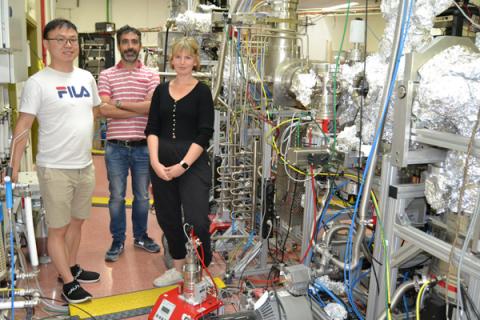ICMM's Stardust machine receives its second European users thanks to the NFFA project

There is some unique stuff at the Instituto de Ciencia de Materiales de Madrid (ICMM), CSIC, and one of them is the Stardust machine, an equipment that combines various techniques to perform original studies on nanoparticles. This is the only one that exists in the world, and it was developed entirely by ICMM's researchers.
That is why some researchers worldwide come to the ICMM to use it, and that is the case with our last visitors. Mario Accolla, from the Osservatorio Astrofisico di Catania (INAF) in Sicily (Italy), and Alejandra Traspas and Jin Zhang, from Queen Mary University in London (United Kingdom), have come to the ICMM to work with the Stardust machine thanks to the Nanoscience Foundries and Fine Analysis (NFFA Europe) project. This is the second time some researchers can work with this machine thanks to NFFA Europe.
"We want to produce some silicon oxide nanoparticles at the conditions encountered in dying stars", explains Accolla, who also was a post-doc at ICMM some years ago. "I'm an astrophysicist working in laboratory astrochemistry, this is my work", he adds. The group will stay at the ICMM for two weeks and they expect to produce enough results to work with. "If not, maybe the researchers working at Stardust could repeat some experiments, we'll see", he adds about the time granted to access the machine, the maximum permitted per NFFA proposal.
The Stardust machine
The Stardust machine can simulate the creation of cosmic dust under the conditions of dying stars. This helps to understand how nanometric dust forms starting from atoms. In the case of this group, they will work with silicon, but the machine can work with atoms from other chemical elements such as iron or carbon.
This facility produces and analyzes in-situ highly-controlled analogs of cosmic dust nanograins in a versatile ultra-high-vacuum (UHV) experiment, down to pressures of 10-10 mbar, so it can reproduce the physical conditions that prevail in the photospheres of Assymptotic Giant Brach (AGB) stars, it means when stars are dying. In this environment, the machine mimics the nucleation of the dust and its possible interaction with the circumstellar gases. Stardust characterizes atomic processes (for instance, the interaction with photons and gas) through surface science techniques. It encompasses 5 independent vacuum chambers, with their own instrumentation, pumping systems, and gas-dosing systems in a highly-controlled UHV environment.
The NFFA project
NFFA Europe is a pan-European consortium of 22 international partners with a core of 13 co-located nanofoundries and Large-Scale facilities, such as synchrotron or neutron radiation sources. The NFFA Europe research infrastructure integrates nanofoundries (synthesis, growth, and manipulation of nanostructures) with fine analysis, theory, and simulation. Due to the wide spectrum of available techniques and services, researchers accessing the NFFA-Europe facilities can control and design the properties of materials from the nano to the micro-scale, and even up to the macro-scale.
The consortium offers more than 180 techniques available to users in the field of nanoscience and nano-microtechnology. The aim of this European project is to allow researchers to face complex nanoscience challenges that cannot be provided by any single research infrastructure alone. In fact, sites are available free of charge, and NFFA Europe also provides support for travel and subsistence costs for the users while accessing the installations.
"It is one of our aims to create a sustainable, long-term research infrastructure and to train a new generation of researchers in formulating their science objectives and research work programs by taking full advantage of NFFA Europe research infrastructure", explains Giorgio Rossi, coordinator of the project.
Photo: (Left to right) Jin Zhang, Mario Accolla and Alejandra Traspas with the Stardust machine at ICMM.
-- Ángela R. Bonachera - ICMM Comunication / Photo: Carlos Arroyo (Morgan) --
Instituto de Ciencia de Materiales de Madrid (ICMM)
Sor Juana Ines de la Cruz, 3
Cantoblanco, 28049
Madrid, España
Telephone: (+34) 91 334 90 00
Email: @email
Communication Office: @email

Acknowledge the Severo Ochoa Centres of Excellence program through Grant CEX2024-001445-S/ financiado por MICIU/AEI / 10.13039/501100011033

Contacto | Accesibilidad | Aviso legal | Política de Cookies | Protección de datos